| dc.contributor.advisor | Butler, Elizabeth C., | en_US |
| dc.contributor.author | Zhu, Xingdong. | en_US |
| dc.date.accessioned | 2013-08-16T12:21:03Z | |
| dc.date.available | 2013-08-16T12:21:03Z | |
| dc.date.issued | 2007 | en_US |
| dc.identifier.uri | https://hdl.handle.net/11244/1320 | |
| dc.description.abstract | Key words: Aqueous ammonia, Titanium dioxide, pH, Inorganic anions, Surfactants, Hydroxyl radicals, Graywater | en_US |
| dc.description.abstract | Global water consumption has been increasing due to population growth. Accordingly, water recycling is a good strategy to compensate for the increased water demand. The overall objective of this study was to investigate the feasibility of using titanium dioxide (TiO2)-photocatalysis to recycle graywater in a simplified model system. We evaluated effects of three major parameters, including pH, inorganic anions, and surfactants, on the photocatalytic degradation of aqueous ammonia (NH4+ /NH3) in graywater in a bench scale reactor. Our results show that higher initial rates of NH4+/NH3 photocatalytic oxidation were obtained in higher pH solutions, and the initial rates were proportional to the initial concentrations of neutral NH3, and not total NH3 (i.e., [NH4 +] + [NH3]). We conducted experiments on the effects of four inorganic anions (Cl-, SO42-, H2PO4-/HPO42-, and HCO3-/CO32-) on NH 4+/NH3 degradation at pH ∼ 9 and ∼ 10 and nitrite (NO2-) oxidation over the pH range of 4-11. Cl-, SO42-, and HCO3 - had no effect on NH4+/NH3 and NO2- photocatalytic oxidation at pH ∼ 9 and ∼ 10, whereas CO32- slowed NH4+/NH 3 but not NO2- photocatalytic oxidation at pH ∼ 11. While HPO42- enhanced NH4 +/NH3 photocatalytic oxidation at pH ∼ 9 and ∼ 10, H2PO4-/HPO42- inhibited NO2- oxidation at low to neutral pH values. Photocatalytic oxidation of NH4+/NH3 to NO2- is the rate-limiting step in the complete oxidation of NH4+/NH3 to NO3 - in the presence of common wastewater anions at pH > 9. As for surfactants, their degradation rates were faster than that of NH4+/NH 3 at pH ∼ 10.1. Surfactant significantly slowed the initial rates of NH4+/NH3 degradation, with the detrimental effect increasing in the order sodium dodecylbenzene sulfonate (SDBS) < cetylpyridinium chloride (CPC) < nonylphenol polyethoxylate (10) (NP10). Adsorption of surfactants could not explain the slower initial rates of NH 4+/NH3 photocatalytic degradation in the presence of 2 x 10-5 M surfactants. We concluded that formation of hydroxyl radical (˙ OH) scavengers, including formate and carbonate, from the photocatalytic degradation of surfactants was the main reason for decreasing initial rates of NH4+/NH3 degradation. Our results show that TiO2 photocatalysis can remove both carbonaceous and nitrogenous biological oxygen demand (CBOD and NBOD), which has implications in graywater recycling. | en_US |
| dc.format.extent | xiii, 139 leaves : | en_US |
| dc.subject | Ammonia. | en_US |
| dc.subject | Water reuse. | en_US |
| dc.subject | Surface active agents. | en_US |
| dc.subject | Engineering, Environmental. | en_US |
| dc.subject | Graywater (Domestic wastewater) | en_US |
| dc.title | Effects of pH, inorganic anions, and surfactants on the photocatalytic degradation of aqueous ammonia in graywater. | en_US |
| dc.type | Thesis | en_US |
| dc.thesis.degree | Ph.D. | en_US |
| dc.thesis.degreeDiscipline | School of Civil Engineering and Environmental Science | en_US |
| dc.note | Adviser: Elizabeth C. Butler. | en_US |
| dc.note | Source: Dissertation Abstracts International, Volume: 69-04, Section: B, page: 2556. | en_US |
| ou.identifier | (UMI)AAI3307012 | en_US |
| ou.group | College of Engineering::School of Civil Engineering and Environmental Science | |
